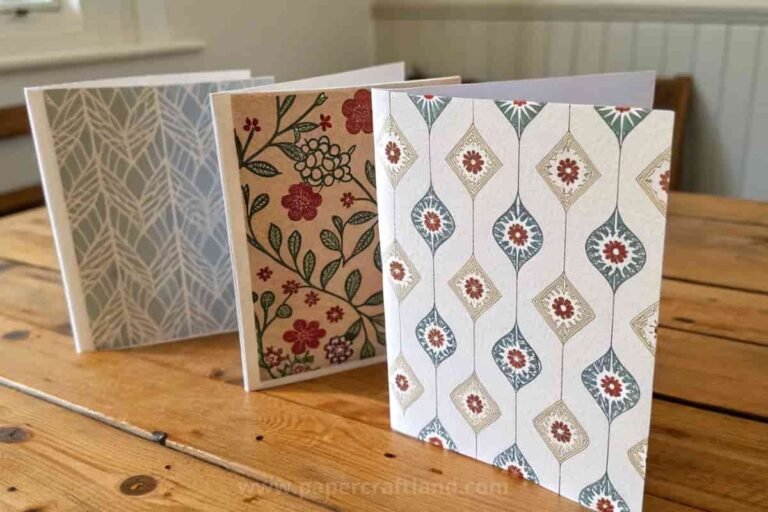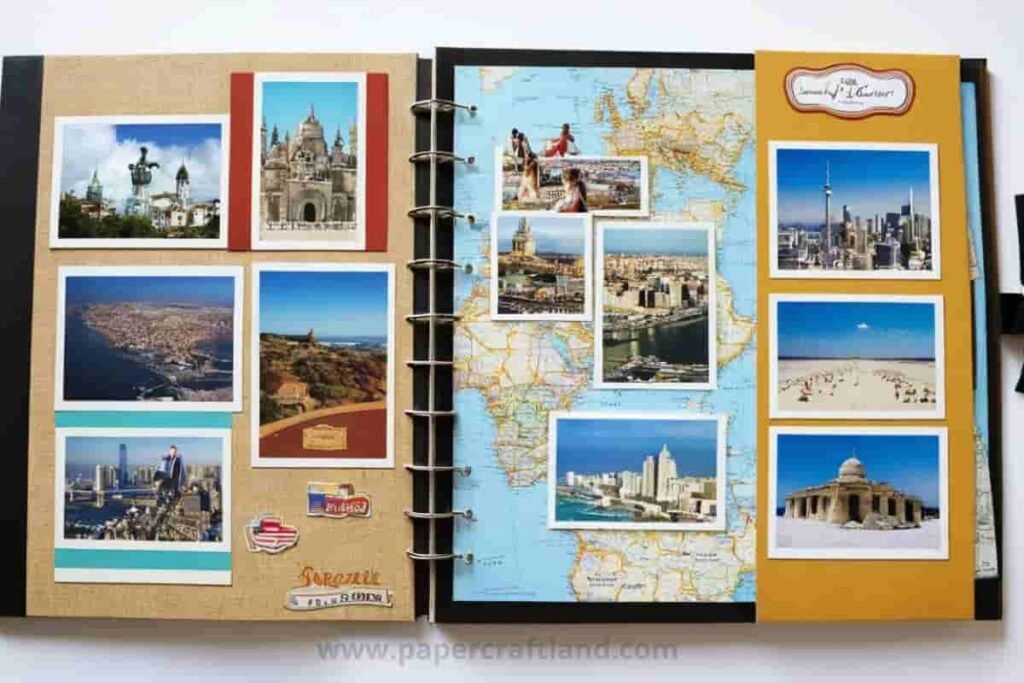In a world driven by digital communication, where most greetings happen through a quick text or an email, handmade greeting cards stand out as a special way to connect with others.
They are a labor of love, combining creativity, effort, and personal attention to create something far more meaningful than the mass-produced cards in stores.
With a resurgence in DIY culture and a growing appreciation for craftsmanship, handmade greeting cards are making a major comeback. Whether for birthdays, holidays, or just to say “thank you,” these cards provide a tangible and lasting expression of care.
But what makes handmade greeting cards so unique? It’s all in the details—the thought behind the design, the time spent creating them, and the personal touches that make each card one-of-a-kind. In an era where convenience often wins, taking the time to handcraft a greeting card for someone shows just how much you value them.
Let’s explore the rich history, creative process, and lasting appeal of handmade greeting cards, along with tips and tricks to create your own.
- History of Greeting Cards
- Why Choose Handmade Over Store-Bought Cards?
- The Creative Process Behind Handmade Cards
- Types of Handmade Greeting Cards
- Step-by-Step Guide to Creating a Handmade Greeting Card
- Popular Themes and Inspirations for Handmade Cards
- Occasions to Give Handmade Greeting Cards
- The Role of Technology in Handmade Greeting Cards
- Eco-Friendly Materials for Handmade Cards
- Handmade Greeting Cards for Kids
- Common Mistakes to Avoid in Handmade Cards
- Benefits of Making Handmade Greeting Cards
- Conclusion
- FAQs
History of Greeting Cards
The tradition of sending greeting cards dates back thousands of years, with early examples seen in ancient China and Egypt. In China, people exchanged messages of goodwill to celebrate the New Year, while in Egypt, papyrus scrolls were used to send greetings and announcements.
The idea caught on in Europe during the Renaissance, and by the 19th century, greeting cards became widely accessible thanks to advances in printing technology. The introduction of postage stamps also made it easier for people to send cards worldwide.
As greeting cards grew more popular, the market for mass-produced cards flourished. Companies like Hallmark began producing millions of cards annually, making it simple to pick up a card for any occasion. However, the ease and affordability of store-bought cards led to a certain lack of personalization, which is why many have turned to making their own.
Why Choose Handmade Over Store-Bought Cards?
One of the biggest reasons to choose handmade greeting cards is the level of personalization and creativity they offer. Store-bought cards may come with pre-written messages, but handmade cards give you complete control over every aspect of the design and content.
From choosing the perfect color scheme to adding personal details like photos or inside jokes, a handmade card can be tailored specifically to the recipient.
Handmade cards also carry emotional weight. When someone opens a card they know was made just for them, it’s clear how much thought and effort went into the gesture.
In a way, these cards become keepsakes—something to be cherished rather than discarded after a few days. Additionally, creating your cards is an eco-friendly alternative, especially when using recycled materials or sustainable supplies. This is a wonderful way to give back to the planet while giving joy to your loved ones.
The Creative Process Behind Handmade Cards
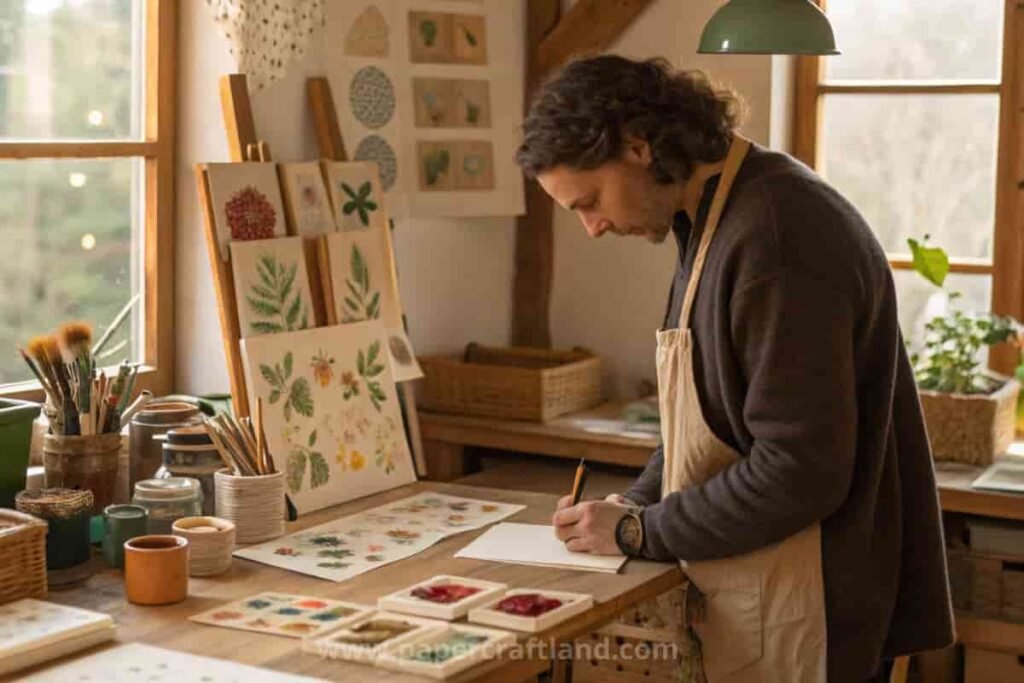
Making a handmade greeting card is as much about the process as the result. It’s an opportunity to express your creativity while making something meaningful for someone else. Whether you’re inspired by nature, holidays, or personal memories, the creative process starts with finding that spark of inspiration.
Once you have a theme, gather your tools and materials—cardstock, scissors, markers, and glue are essentials. Depending on the design, you might also want to use embellishments like buttons, ribbons, or glitter.
Popular techniques in card-making include paper crafting (cutting and shaping paper for dimensional effects), calligraphy for elegant text, and watercolor painting for soft, artistic designs.
The beauty of handmade cards is that there are no limits—every technique, whether simple or advanced, brings its charm. Adding a personal touch like a handwritten message, a family photo, or even a pressed flower makes the card uniquely yours.
Types of Handmade Greeting Cards
There’s a handmade card for every occasion, each with flair and personality. Here are some common types:
- Birthday Cards: These can range from fun and playful for children to elegant and sophisticated for adults. Personalized touches like the recipient’s name or age add to the uniqueness.
- Holiday Cards: From Christmas to Halloween, holiday cards can embrace traditional designs or more creative themes. Snowflakes, reindeer, pumpkins, and autumn leaves are all classic motifs.
- Thank You Cards: Simple and sincere, thank you cards are a great way to express gratitude. A heartfelt message paired with a minimalist design is all you need.
- Congratulations Cards: Whether celebrating a wedding, a new baby, or a promotion, congratulations cards allow you to share in someone’s joy. Adding details like gold accents or glitter can make the card feel celebratory.
- Sympathy and Get-Well Cards: Offering comfort and support, these cards are more subdued in design but just as heartfelt. Soft colors and gentle messages go a long way.
- Invitation Cards: Handmade invitations for weddings, baby showers, or parties add a personal touch that sets the tone for the event. Matching the design to the event theme makes the invite even more special.
Step-by-Step Guide to Creating a Handmade Greeting Card
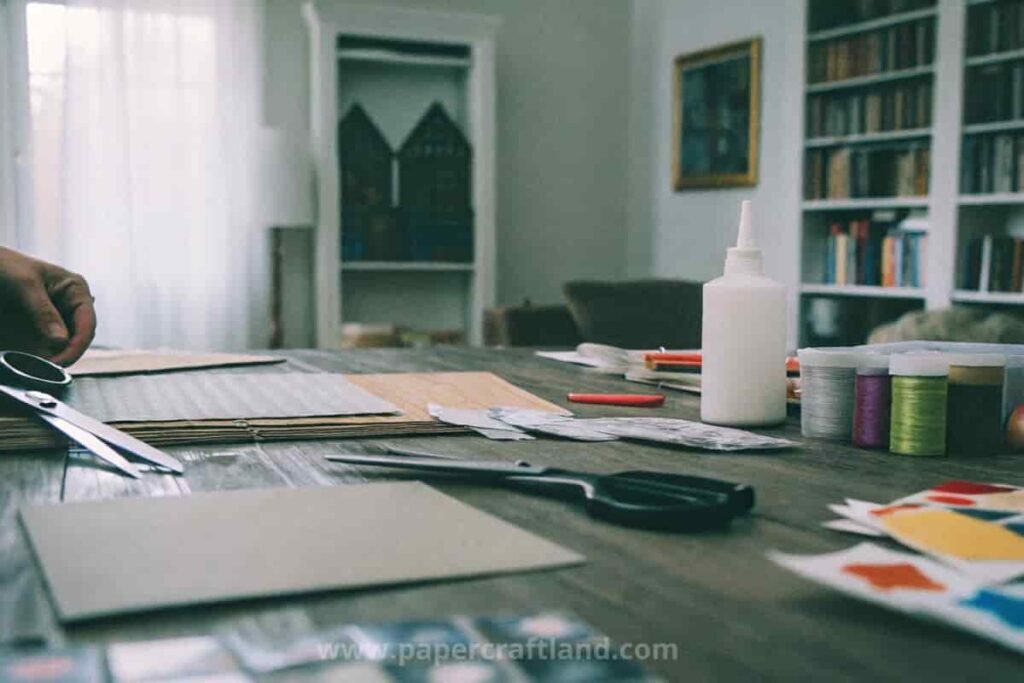
If you’re ready to make your greeting card, here’s a simple step-by-step guide:
Step 1: Gather your materials. You’ll need basic supplies like cardstock, scissors, glue, markers, and any embellishments you want to add.
Step 2: Plan your design. Think about the theme of the card and choose a color palette and layout that fits. Sketch out a rough design if needed.
Step 3: Add the main visual elements. Cut out shapes, draw illustrations, or add stickers and embellishments. Make sure to balance the design so it’s visually appealing.
Step 4: Write a heartfelt message inside. This is the key element of the card.
Make an effort to write something heartfelt and personal.
Step 5: Add final touches. Whether it’s a decorative border, a bit of glitter, or 3D elements like paper flowers, these small details can make your card stand out.
Popular Themes and Inspirations for Handmade Cards
Need inspiration? Handmade greeting cards can draw from countless themes:
- Nature: Incorporate elements like flowers, trees, or animals for a natural, serene look.
- Minimalist: Clean lines, simple color schemes, and modern fonts create a chic, contemporary card.
- Vintage: Use muted colors, lace, and antique-style illustrations to give your card a nostalgic feel.
- Seasonal: Change your designs with the seasons—spring pastels, summer brights, autumn hues, and winter whites.
Occasions to Give Handmade Greeting Cards
Handmade cards aren’t just for birthdays or holidays. They can be given on any occasion or even without one. Some ideas:
- Birthdays: Personalizing a birthday card with the recipient’s favorite colors or hobbies makes it more special.
- Holidays: Create a set of holiday cards to send to family and friends. Seasonal designs like snowmen or pumpkins add to the festive spirit.
- Random Acts of Kindness: Send a card just because! It could be to brighten someone’s day or to let them know you’re thinking of them.
The Role of Technology in Handmade Greeting Cards
Interestingly, even though handmade cards are considered traditional, technology can play a role in the creative process. Graphic design tools like Canva or Adobe Illustrator allow you to create intricate designs that can be printed and incorporated into your card.
You can even print out photos, custom fonts, and illustrations to blend digital and physical elements seamlessly.
Eco-Friendly Materials for Handmade Cards
If sustainability is important to you, there are plenty of eco-friendly materials you can use for handmade cards. Look for recycled paper or cardstock, and avoid embellishments that aren’t biodegradable. Reusing scraps, old magazines, or dried flowers can add texture and color without the environmental impact.
Handmade Greeting Cards for Kids
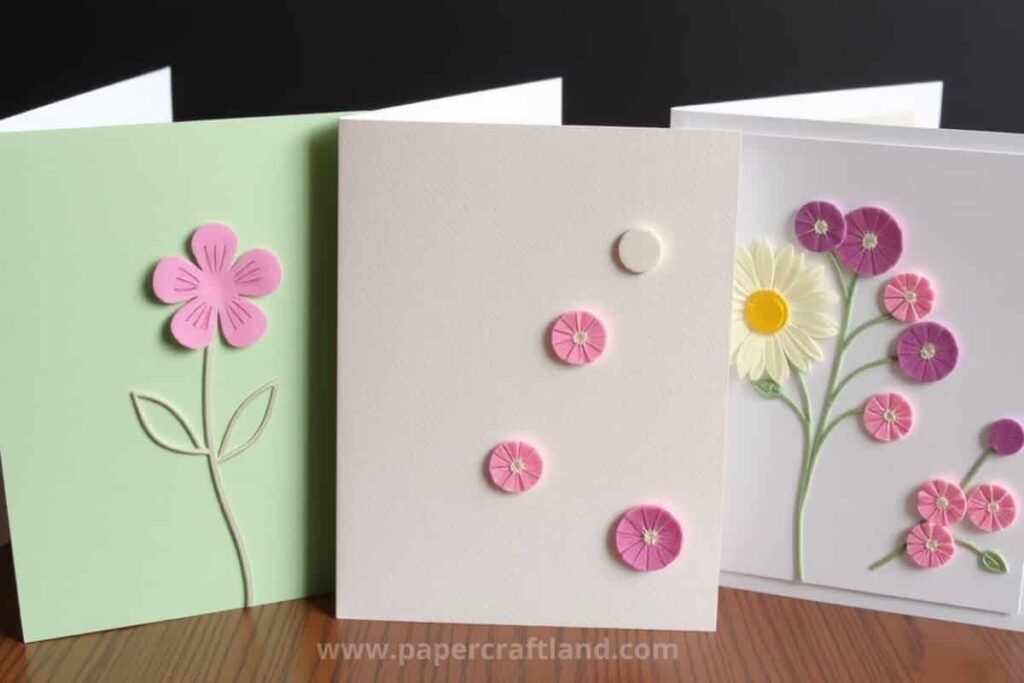
Making greeting cards is a fantastic activity for children, too. Simple designs with colorful markers, stickers, and stamps can keep kids entertained while allowing them to express their creativity. Kid-friendly materials like safety scissors, glue sticks, and washable markers ensure that the process is both fun and safe.
Common Mistakes to Avoid in Handmade Cards
When making handmade greeting cards several common mistakes can detract from the final result or make the process more difficult than it needs to be. Here are some key mistakes to avoid, along with tips on how to steer clear of them:
Overcomplicating the Design
A common trap for beginners is trying to include too many elements in one card, which can make the design look cluttered or chaotic. While it’s tempting to use all your supplies—stickers, glitter, ribbons, and more—less is often more when it comes to handmade cards.
How to avoid it:
Stick to a cohesive theme and limit yourself to a few design elements that work well together. Focus on simplicity and balance, ensuring the card remains elegant and visually appealing.
Using Low-Quality Materials
Handmade cards are special because they’re crafted with care, but using low-quality materials can make the card look cheap and fragile. Flimsy paper, weak adhesives, or faded markers can detract from your hard work.
How to avoid it:
Invest in good-quality cardstock, markers, and adhesives. While it’s not necessary to splurge on premium items, using sturdy materials ensures the card will last longer and look more professional.
Forgetting to Plan the Layout
Diving straight into card-making without a plan can lead to poor composition. Elements may end up crooked, unbalanced, or misplaced, making the card look less polished.
How to avoid it:
Before cutting or gluing anything, sketch out a rough layout of your design. Consider the placement of key elements like text, images, and embellishments to ensure the card looks well-organized.
Skipping the Message Inside
Focusing too much on the exterior design and forgetting about the message inside is another common mistake. The card may look beautiful, but the lack of a heartfelt note can make it feel incomplete or impersonal.
How to avoid it:
Make sure to dedicate time to crafting a meaningful message. Even if the design is elaborate, the personal message inside is often what resonates most with the recipient. Keep it thoughtful and relevant to the occasion.
Not Allowing Enough Time for Drying
Using materials like glue, paint, or ink often requires drying time. Rushing to finish the card before the materials are fully dry can lead to smudging, warping, or even falling apart.
How to avoid it:
Be patient and allow adequate time for each layer or element to dry before adding the next. If you’re using glue or paint, let it sit for at least a few hours (or overnight, if needed) to prevent smudging or sticking.
Overuse of Embellishments
While embellishments like glitter, buttons, and ribbons can enhance a card, using too many can overwhelm the design. Over-embellishment can also make the card bulky and difficult to mail.
How to avoid it:
Choose one or two embellishments that complement your design. Be mindful of the card’s size and weight, especially if it needs to fit in an envelope or be mailed.
Ignoring Color Harmony
Clashing colors can make your card look disorganized and chaotic. Choosing a color palette that doesn’t harmonize can take away from the card’s overall beauty.
How to avoid it:
Stick to a cohesive color scheme, using complementary colors that enhance each other. Neutral tones or simple, contrasting colors often work best to maintain visual harmony.
Forgetting About the Back of the Card
Many crafters focus solely on the front and inside of the card, neglecting the back. A blank or unfinished back can make the card feel incomplete.
How to avoid it:
Add a simple detail to the back of the card, such as your signature, a small design, or even a “Handmade with Love” stamp. This small touch adds professionalism and completes the card.
Rushing the Crafting Process
In a rush to finish, you might make careless mistakes such as cutting shapes unevenly, misaligning pieces, or using too much glue, leading to a messy final product.
How to avoid it:
Take your time, especially with intricate details. Measure and cut carefully, and double-check alignment before adhering to any pieces permanently. Slowing down ensures better precision and a higher-quality result.
Neglecting to Match the Envelope
Making a beautiful card only to put it in an ill-fitting or mismatched envelope can reduce its impact. An envelope that’s too big, small, or clashing in color can lessen the overall presentation.
How to avoid it:
Make or choose an envelope that matches the style, size, and theme of your card. A well-coordinated envelope enhances the handmade card experience and creates a polished look.
Benefits of Making Handmade Greeting Cards
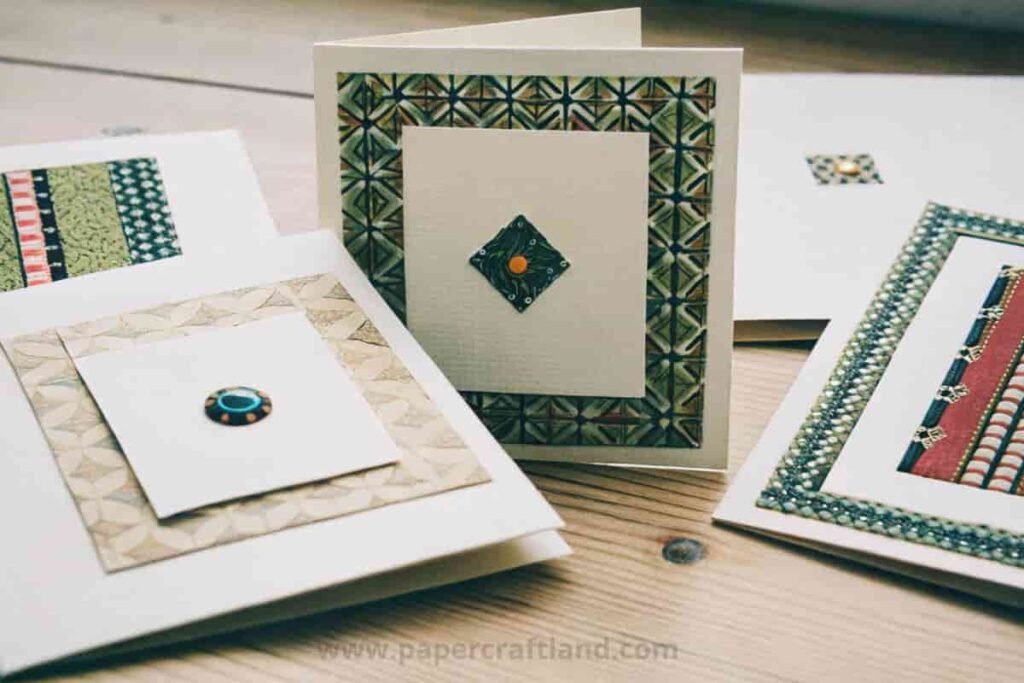
Creating handmade greeting cards offers a range of benefits that go beyond simply producing a beautiful, personalized product.
Whether crafting cards for special occasions or as a creative hobby, making your greeting cards can enrich your life in many meaningful ways. Here’s a deeper dive into the various benefits:
Personal Expression and Creativity
One of the biggest advantages of making handmade greeting cards is the opportunity to express yourself creatively. Unlike store-bought cards, which are often generic, handmade cards allow you to pour your ideas, style, and personality into each design. Every card becomes a reflection of your artistic flair, preferences, and emotions.
How it benefits you:
Handmade cards give you complete control over the design process, from choosing the theme and colors to adding personal touches like photos or handwritten notes. It’s an ideal outlet for unleashing your creativity, whether you prefer bold and colorful designs or elegant and minimalist aesthetics.
Emotional Connection and Thoughtfulness
Handmade greeting cards carry a much deeper emotional weight than mass-produced ones. When you take the time to create a card by hand, the recipient knows to put genuine thought and effort into crafting something just for them. This adds more meaning and sincerity to the gesture.
How it benefits you:
Giving a handmade card strengthens your emotional connection with the recipient, as it’s seen as a labor of love. Whether for a birthday, holiday, or “just because,” a handmade card conveys sincerity, care, and thoughtfulness in a way that store-bought cards often cannot.
Relaxation and Stress Relief
Crafting handmade greeting cards is a mindful, relaxing activity that can help reduce stress. Engaging in creative tasks like cutting, painting, gluing, or sketching allows you to focus on the present moment, which can be a soothing escape from the pressures of everyday life.
How it benefits you:
As with other forms of crafting, making cards can put you in a state of “flow,” where you become fully immersed in the process. This mental state promotes relaxation, reduces anxiety, and can even improve focus and concentration. It’s an excellent way to unwind after a long day or to practice mindfulness in a low-pressure setting.
Improving Fine Motor Skills and Cognitive Function
Making handmade cards involves fine motor skills, including cutting, gluing, drawing, and folding. These actions require precision and control, which can help improve hand-eye coordination and dexterity.
How it benefits you:
For children and adults, crafting greeting cards is a great way to exercise and refine motor skills. It’s especially beneficial for older adults looking to maintain cognitive function and dexterity, or for young children who are still developing these abilities.
Affordable and Eco-Friendly
Handmade greeting cards can be much more affordable than you might think, especially when you use recycled or repurposed materials. Instead of buying expensive store-bought cards, you can use materials you already have at home—such as old magazines, fabric scraps, or recycled paper—to create unique designs.
How it benefits you:
This DIY approach not only saves money but also allows you to adopt an eco-friendly crafting practice. By reusing materials and reducing the need for new, mass-produced products, you contribute to sustainability efforts while creating beautiful and thoughtful cards.
Customization for Any Occasion
One of the greatest advantages of handmade greeting cards is the ability to fully customize them for any occasion. Whether it’s a birthday, anniversary, or holiday, you can design a card specifically for the event, ensuring it matches the personality and interests of the recipient.
How it benefits you:
Handmade cards allow you to tailor every detail, from the imagery to the colors and message. You can make the card humorous, sentimental, or inspirational depending on the recipient’s preferences, ensuring it feels extra special and personal.
Fostering Connections and Strengthening Relationships
When you make a handmade greeting card, you’re doing more than just giving a gift to nurture your relationships. Handmade cards can help build stronger emotional bonds, as they show care and thoughtfulness that extend beyond material gifts.
How it benefits you:
Taking the time to make a card for someone demonstrates that they’re important to you, which can deepen your connection and appreciation for one another. It’s a simple yet powerful way to maintain and strengthen relationships, especially in today’s fast-paced world.
Gaining a Sense of Accomplishment
There’s something incredibly rewarding about completing a handmade project. After investing time and effort into designing and crafting a card, you get the satisfaction of seeing your creation come to life. That accomplishment can boost your confidence and encourage you to take on more creative challenges.
How it benefits you:
Making handmade cards can increase your sense of self-worth and creativity. As you improve your crafting skills and try new techniques, you build confidence in your abilities, which can spill over into other areas of life.
Unique and One-of-a-Kind Gifts
Handmade cards are truly one-of-a-kind, and no two cards are ever the same. Even if you follow a similar design each time, the handmade nature of the card ensures that each one has its unique characteristics.
How it benefits you:
Giving something that can’t be found anywhere else makes your card feel even more special. It becomes a cherished keepsake for the recipient, who will likely treasure it far longer than they would a store-bought card.
Social and Community Benefits
Crafting handmade cards can also bring social benefits. Whether creating cards as part of a crafting group or donating handmade cards to charitable causes (such as sending them to hospitals, nursing homes, or military members), making cards can foster community and connection.
How it benefits you:
Participating in group crafting sessions or giving back to your community through handmade cards can provide a sense of belonging and shared purpose. It’s a wonderful way to connect with like-minded individuals and make a positive impact through your creativity.
Developing Problem-Solving and Planning Skills
Crafting a handmade card involves planning, creativity, and problem-solving. You need to think about the layout, the materials you’ll use, and how to execute your design in a visually appealing way. These steps help you think critically and develop practical solutions when you encounter challenges, such as limited supplies or design issues.
How it benefits you:
By practicing these skills, you improve your ability to think on your feet and come up with creative solutions. This can have benefits not just in card-making, but in other aspects of life, from work to home projects.
Opportunities for Business Ventures
If you’re passionate about making handmade greeting cards, you can turn your hobby into a small business. Platforms like Etsy, craft fairs, or local markets offer opportunities to sell your creations and earn an income from your passion.
How it benefits you:
Selling your cards can help you earn extra income while doing something you love. It also provides a sense of accomplishment, knowing that others value and appreciate your work. Plus, it gives you the chance to connect with other crafters and build a community around your business.
Creating Lasting Memories
Handmade greeting cards often become keepsakes, holding sentimental value for years. Many people keep these cards as mementos of special moments, storing them in memory boxes or displaying them on shelves.
How it benefits you:
Knowing that your handmade card could become a treasured part of someone’s memories makes the process even more fulfilling. You’re not just giving a card you’re creating something that could hold lasting emotional value.
Conclusion
Handmade greeting cards are more than just paper—they’re a personal expression of love, creativity, and thoughtfulness.
In a world where so much communication is digital, receiving a handmade card feels like receiving a piece of art. Whether making them for loved ones or selling them as part of a business, these cards are timeless tokens of care that will always hold value in a fast-paced, tech-driven world.
FAQs
- What supplies do I need to create a handmade greeting card?
You’ll need cardstock, scissors, glue, markers, and optional embellishments like ribbon or stickers.
- How long does it take to make a handmade greeting card?
It depends on the complexity, but most cards can be completed in 30 minutes to an hour.
- Can I sell handmade greeting cards online?
Yes! Platforms like Etsy are great for selling handmade cards, and social media can help you promote your work.
- What’s the best way to make eco-friendly cards?
Use recycled paper, natural embellishments, and non-toxic inks to keep your cards sustainable.
- Do I need to be artistic to make handmade cards?
Not at all! Simple designs with heartfelt messages can be just as meaningful as intricate ones. Creativity comes in many forms!
- Can I use digital tools to design handmade cards?
Yes, you can create designs using graphic tools like Canva or Photoshop, print them, and add personal, handmade touches.
- What occasions are best for handmade greeting cards?
Handmade cards are perfect for birthdays, holidays, weddings, or even just to say “thank you” or “thinking of you.”
- How can I personalize my handmade greeting cards?
You can personalize cards by adding the recipient’s name, including photos, or incorporating personal messages and favorite colors.

